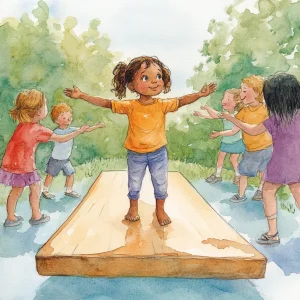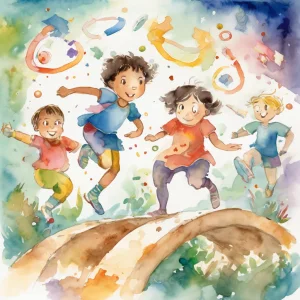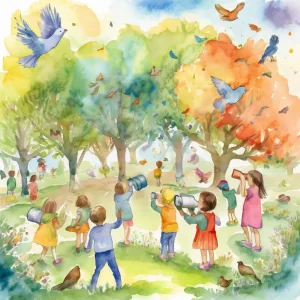Activity
Similar Activities
Balance Beam Adventure: Enhancing Coordination and Focus
Children’s Age: 2–12 years
Activity Duration: 5 minutes
This fun activity called "Balancing Act Fun" is perfect for kids aged 2 to 6. It helps improve coordination, balance, and self-regulation. You'll need a flat surface, a stable boar…
Activity Duration: 5 minutes
Enchanted Musical Storytime Adventure
Children’s Age: 2–2.5 years
Activity Duration: 5 – 15 minutes
Join the "Musical Storytime Adventure" for children aged 24 to 30 months, focusing on self-regulation development. Gather favorite storybooks, musical instruments, a cozy rug, and …
Activity Duration: 5 – 15 minutes
Enchanted Forest: The Nature Scavenger Hunt
Children’s Age: 2–6 years
Activity Duration: 15 minutes
Let's go on a Nature Scavenger Hunt to explore and enjoy nature! You'll need a basket, a list of items to find, paper, markers, and maybe some magnifying glasses. Choose a safe out…
Activity Duration: 15 minutes
Enchanted Forest: Nature Theater Digital Adventure
Children’s Age: 6–10 years
Activity Duration: 30 minutes
The "Nature Theater: Digital Storytelling Adventure" activity blends nature, theater, and technology to nurture children's creativity, cognitive skills, and self-regulation abiliti…
Activity Duration: 30 minutes
Enchanted Cultural Nature Walk: A Journey of Discovery
Children’s Age: 4–6 years
Activity Duration: 25 minutes
Embark on a "Cultural Nature Walk" with children aged 48 to 72 months to foster self-regulation and cultural appreciation in a natural setting. Prepare with paper bags, cultural ar…
Activity Duration: 25 minutes
Adventure through the Healthy Lifestyle Obstacle Course
Children’s Age: 4–6 years
Activity Duration: 15 – 20 minutes
Engage children aged 48 to 72 months in the "Healthy Lifestyle Obstacle Course" to promote self-regulation and cognitive development through fun physical activities. Set up station…
Activity Duration: 15 – 20 minutes
Seasonal Shapes Playdough Sculpting Adventure
Children’s Age: 4–6 years
Activity Duration: 15 – 20 minutes
Engage children aged 48 to 72 months in a Playdough Sculpting activity focusing on seasonal shapes to boost fine motor skills, creativity, and emotional regulation. Provide playdou…
Activity Duration: 15 – 20 minutes
Enchanted Clay Sculpture Storytelling Forest
Children’s Age: 6–10 years
Activity Duration: 15 – 30 minutes
Engage children aged 6 to 10 in the Clay Sculpture Storytelling activity to foster cultural understanding, play skills, and self-regulation. Gather air-dry or sculpting clay, a tab…
Activity Duration: 15 – 30 minutes
Nature Shapes Adventure: Bird Watch & Scavenger Hunt
Children’s Age: 4–5 years
Activity Duration: 10 minutes
An outdoor activity for children aged 4-5 years combining bird watching and shape recognition.
Activity Duration: 10 minutes
Whispers of Nature: The Nature Story Stones
Children’s Age: 3–4 years
Activity Duration: 20 minutes
The Nature Story Stones activity is designed for children aged 36 to 48 months to boost their communication abilities through nature-themed storytelling. Gather smooth stones, pain…
Activity Duration: 20 minutes
Nature Collage Photo Frames: Creative Storytelling Adventure
Children’s Age: 6–10 years
Activity Duration: 15 – 30 minutes
Children can have fun creating Nature Collage Photo Frames to boost communication skills, creativity, and teamwork. Gather natural items, cardboard, scissors, glue, markers, and a …
Activity Duration: 15 – 30 minutes
Digital Beats and Hoop Dreams Coding Adventure
Children’s Age: 9–12 years
Activity Duration: 10 – 20 minutes
An engaging coding activity integrating music production, basketball skills, and teamwork for children aged 9-12 years.
Activity Duration: 10 – 20 minutes


























